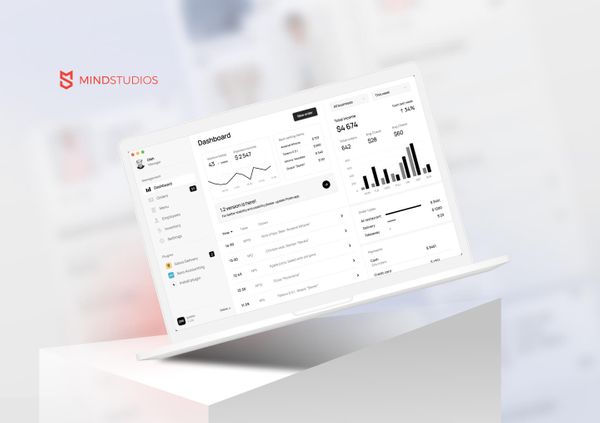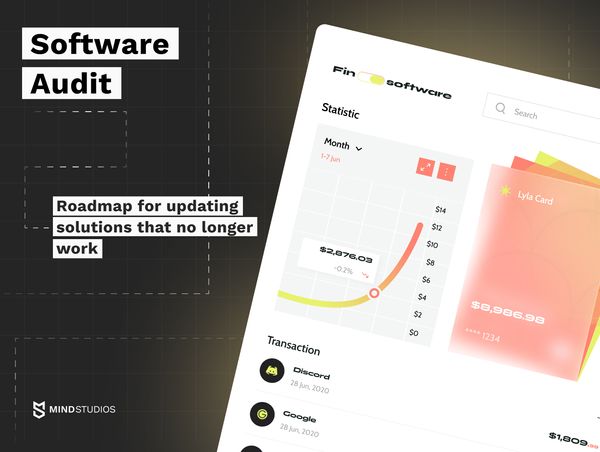
For business owners new to running digital products, a software audit might seem like a technicality. But did you know that investing resources in regular software examinations can actually help you gain more users, save your business money, and even protect you from legal risks?
In this article, we explore what software auditing actually means, answer the questions of when and how to audit software, as well as explain why this procedure should become a standard practice for any software owner out there.
In addition, we also share how Mind Studios software development experts can take on the role of your external auditor and assist you with getting your product to run like clockwork. Now, let's take a closer look at how an audit in software engineering works
What is a software audit and why is it performed?
A software audit is a comprehensive examination of software products, which can involve analyzing its numerous components, including code, infrastructure, security, usability, and other aspects. The audit can focus on just one aspect of the software, or cover all of them at once, depending on its purpose.
There are two primary ways such analysis is conducted:
- Internal audit is conducted regularly by the in-house team and is generally more frequent.
- External audit is performed by a third party and is often aimed at obtaining an unbiased report, especially if the software needs to comply with specific policies, licenses, and legislative regulations. Also, an external audit of software can be requested if the in-house staff lacks the expertise to conduct it.
As for the frequency of auditing in software engineering, internal inspections should be conducted on a regular basis at least twice a year, or no rarer than once every year in the worst-case scenario. With external audits, it depends on the specifics of your business area and your needs.
There is no doubt the advantages of these examinations outweigh the costs spent on them, especially in the long run. Here, we collected the 5 most significant benefits of software audits.
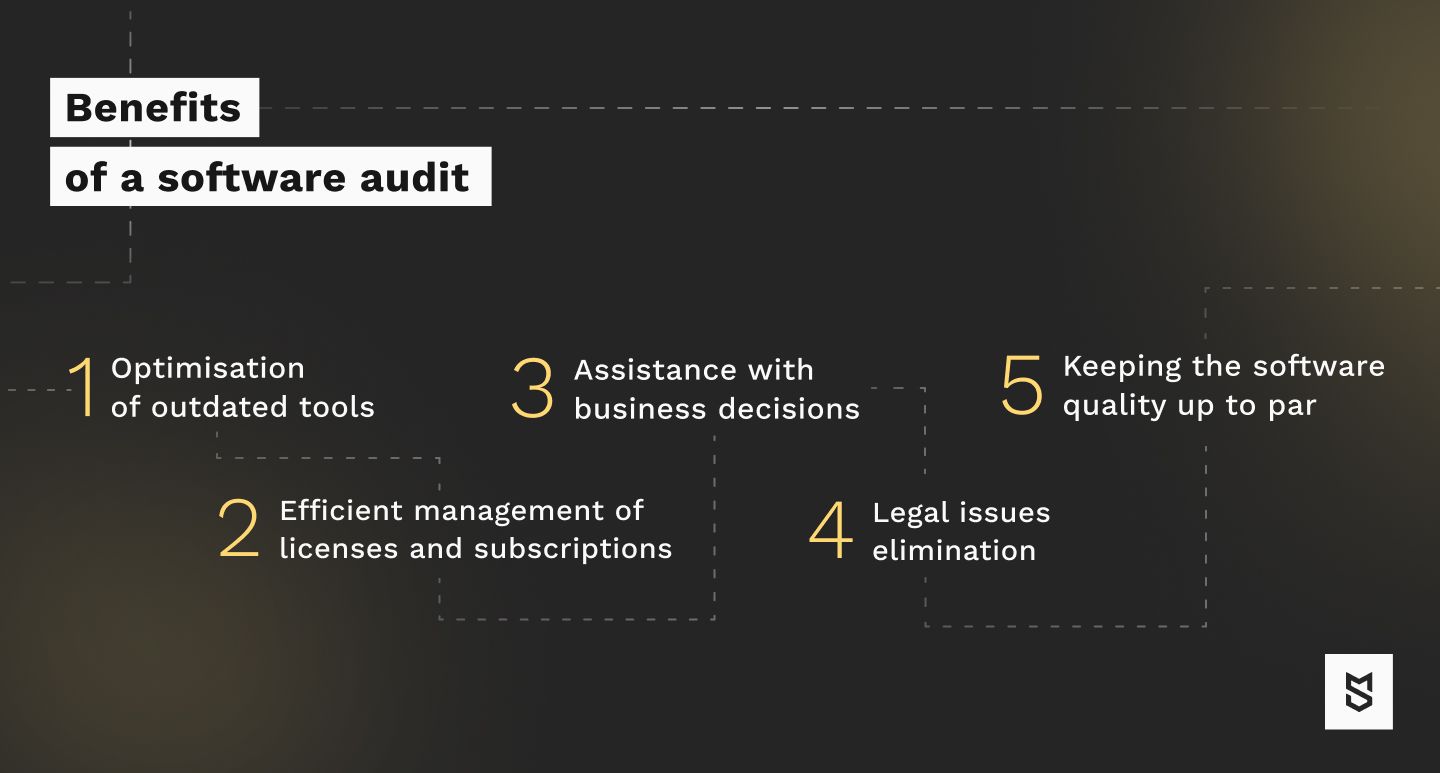
1. Optimization of outdated tools
The most versatile purpose of software audits is checking for tools that no longer contribute to the overall performance of the software or even slow it down. This is the reason software audits should be performed on any kind of software.
As a result of the examination, software owners get a better understanding of the weaknesses that need to be addressed, whether it means they need to replace a few features or update the whole platform.
2. Efficient management of licenses and subscriptions
Running software products often involves dealing with multiple fees for licenses, third-party integrations, and subscriptions. At the same, it can be challenging to keep track of which of them are active and necessary.
One of the goals of a software project audit is to detect inactive licenses and subscriptions, as well as tools the software owners no longer need — and thus help avoid unnecessary expenses.
3. Assistance with business decisions
A thorough audit is an essential part of purchasing software, at least if you don’t want to regret your investment. Before buying any software product, it’s recommended that you check its every aspect, from code style to possible legal liabilities. This will help you determine whether there is any need for significant updates or not, and decide if it’s compatible with your requirements and goals at all.
4. Legal issues elimination
Regular audits help software owners avoid legal issues connected to missing licenses, compliance with essential legal requirements and industry standards, and data breach risks.
For instance, managing software for the healthcare industry involves dealing with tons of sensitive data such as electronic health records. That is why it’s essential for the service or platform to comply with certain certifications, data protection laws, and regulations, like the USA’s HIPAA or the UK’s DPA. And that’s where software audit comes in handy.
5. Keeping the software quality up to par
The key to maintaining a trustworthy software product that constantly grows is introducing regular updates — and those are more effective when implemented based on the results of software audits.
With tech solutions constantly evolving, there are always ways for improvement when it comes to software products, whether in regard to cybersecurity, new features, cloud computing solutions, or product maintainability. Software audits help product owners make an informed decision regarding which problems and updates need to be a priority.
To sum up, a software audit is crucial for ensuring the software is secure, convenient, efficient, and protected from any legal issues. Moreover, all the abovementioned benefits of a software analysis lead to the smart use of resources and save businesses money in the long run.
When should you conduct a software audit?
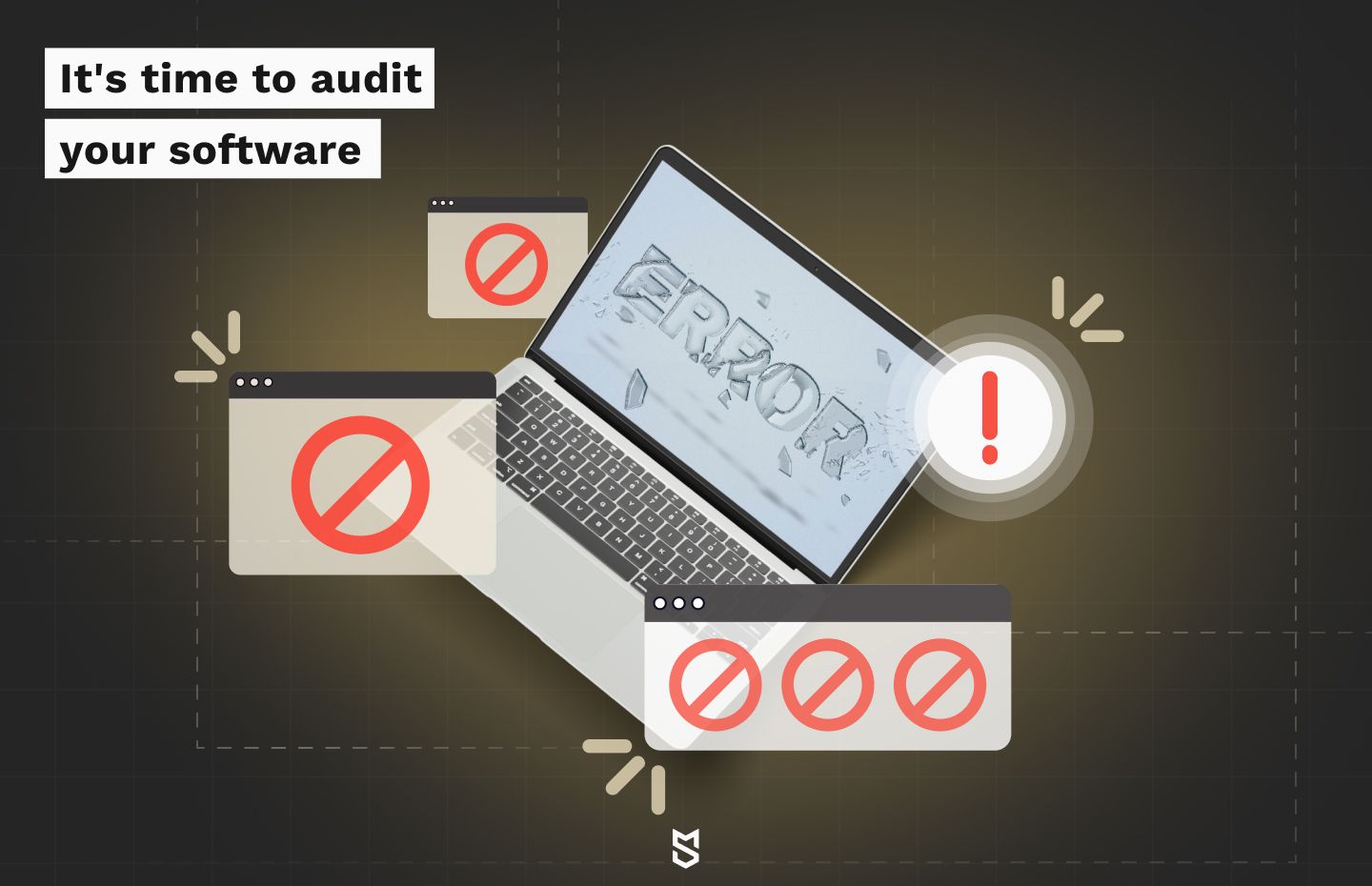
As we’ve already established, every software product needs regular internal comprehensive audits in order to stay secure, up-to-date, and growing. But what about situational audits, including external ones, and when should a software owner request them? We suggest conducting a software inspection when:
- The software product hasn’t been updated in a while and requires new solutions.
- The performance of the product has slowed down, and it’s not properly responsive.
- The software has gone through a data breach or other security hazards.
- The product has stopped being efficient, and your in-house team cannot determine the problem.
- There is a need to reduce costs on maintenance of the product.
- Your in-house team doesn’t have the time or expertise to conduct a proper software audit.
- You want to detect and fix every possible issue before deploying to fleet services.
- You are thinking about purchasing a software product and need to make sure the product is worth going through with it.
It’s worth noting that software audits can be conducted to address just one specific issue instead of examining every aspect of the product. The audit types can also be your cheat sheet that helps determine when you need to request an urgent audit of software. Here, we’ve gathered the most common audit types.
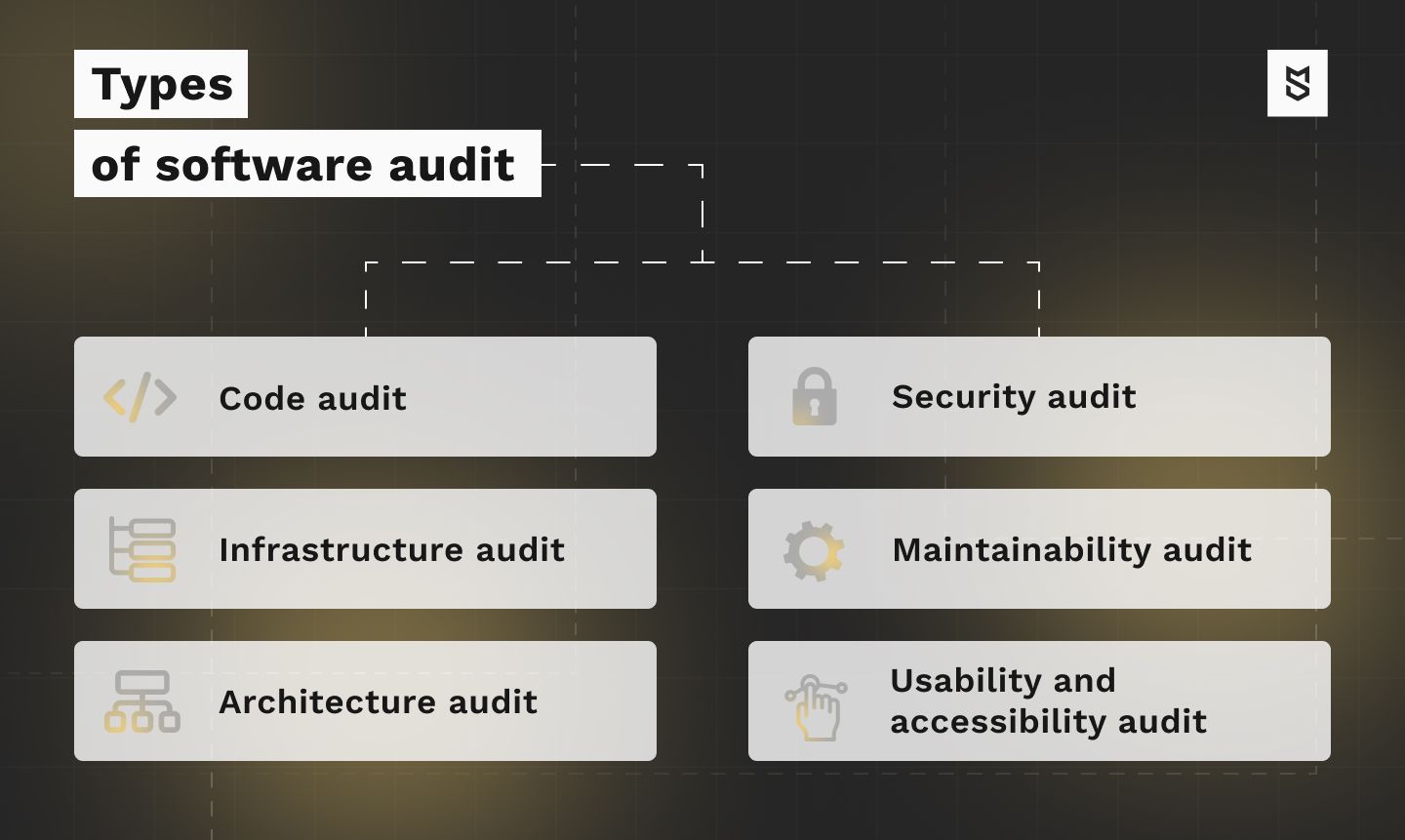
Code audit
Does the code of the software product comply with the industry standards? How easy is it to maintain and scale? These are just a few questions that the code audit (a comprehensive analysis of frontend and backend code) helps find answers to.
Software code audit also helps find existing bugs and detect issues that can arise later, determine technologies that are no longer efficient, and provide recommendations on how the code can be improved. Last but not least, it also helps decide whether the product is ready for scaling.
Infrastructure audit
The goal of an infrastructure audit is to evaluate the performance of all the components that are crucial for development, deployment, and server management. The server here is in the spotlight, since data communication, gateways, and system management directly depend on it.
When analyzing the software infrastructure, the specialists conducting the audit usually pay extra attention to costs, the availability of services, the documentation, and the use of resources.
Architecture audit
The architecture audit procedure is aimed at analyzing the components of the system, checking how effectively they interact with each other, and thus determining how flexible the whole system is. To be more precise, it involves the inspection of databases, services, integrations, and more.
Security audit
The goal of security auditing is to detect and protect the company from possible security threats, such as user data breaches, cyberattacks, data loss, and more. Preventing your product from going through security issues saves your business money in the long run, since those almost inevitably lead to lawsuits, not to mention huge reputational losses.
If there are any potential hazards, a security audit helps detect them and suggest a package of solutions, like investing in malware protection tools, strong firewalls, SSL-encrypted data transmission, and so on.
Maintainability audit
The quality of the code and the choice of technologies directly influence how easy the software is to maintain. The task of the audit here is to point out how this maintainability could be improved by detecting obsolete solutions and chaotic, low-quality code. And though it can be pricey to fix these problems, in the future it will help you lower maintenance expenses.
Usability and accessibility audit
In most cases, the success of your software is defined by how easy it is to access and navigate for your average user. That is why a usability and accessibility audit is a must before you release your software — or if you are not satisfied with the scale of your active user base.
During these audits, we usually find common problems like overly complicated or confusing onboarding, which leads to high bounce rates, and a lack of user-friendly UI/UX design solutions. Those, however, are totally fixable.
What to consider before auditing software?
So, how does one request a software audit? What preparations are there to take care of before the procedure? Here are 4 steps that will help you get ready for the software audit process.

1. Define the main goals of a software audit
Before making a request for a software audit, you need to determine what the main reason for the audit is, and what you expect to get from it.
How do you evaluate the current state of your product? Are there any issues and malfunctions in the software right now? Are you worried about its security? Or do you just want to conduct a comprehensive analysis of the product? These questions will help you define the goal.
2. Create a software product audit checklist
Now that you know the goals you want to achieve with the audit, you can get down to estimating the scope of the audit and creating a checklist for the specialists who will be examining the software.
For instance, depending on the issues your software is going through, the list can include third-party integrations analysis, security examination, sales funnel optimization, and so on.
3. Find a trustworthy software audit partner
In case your team isn’t qualified enough to conduct the chosen type of software audit or you need an unbiased opinion, you can hire a team of audit specialists to conduct the inspection for you. During your communication with the candidates, make sure to check their experience in the relevant industries and go over the reviews from their previous clients.
As a company with extensive experience in software development, Mind Studios also provides software audit services. If you are interested in consulting with us, fill in a contact form, and our team will arrange an online meeting with you to go through your audit checklist for the software development project and discuss further cooperation strategy.
4. Extra tip: internal audits
While it’s not a step in the preparation process for the software audit per se, we have to highlight the importance of software audits conducted regularly by an in-house team.
Even if your specialists do not have the expertise to examine every aspect of the software product, a partial analysis will still help you avoid critical crashes and threats — and thus make external audits less stressful, time-consuming, and costly.
How to conduct a software audit: checklist
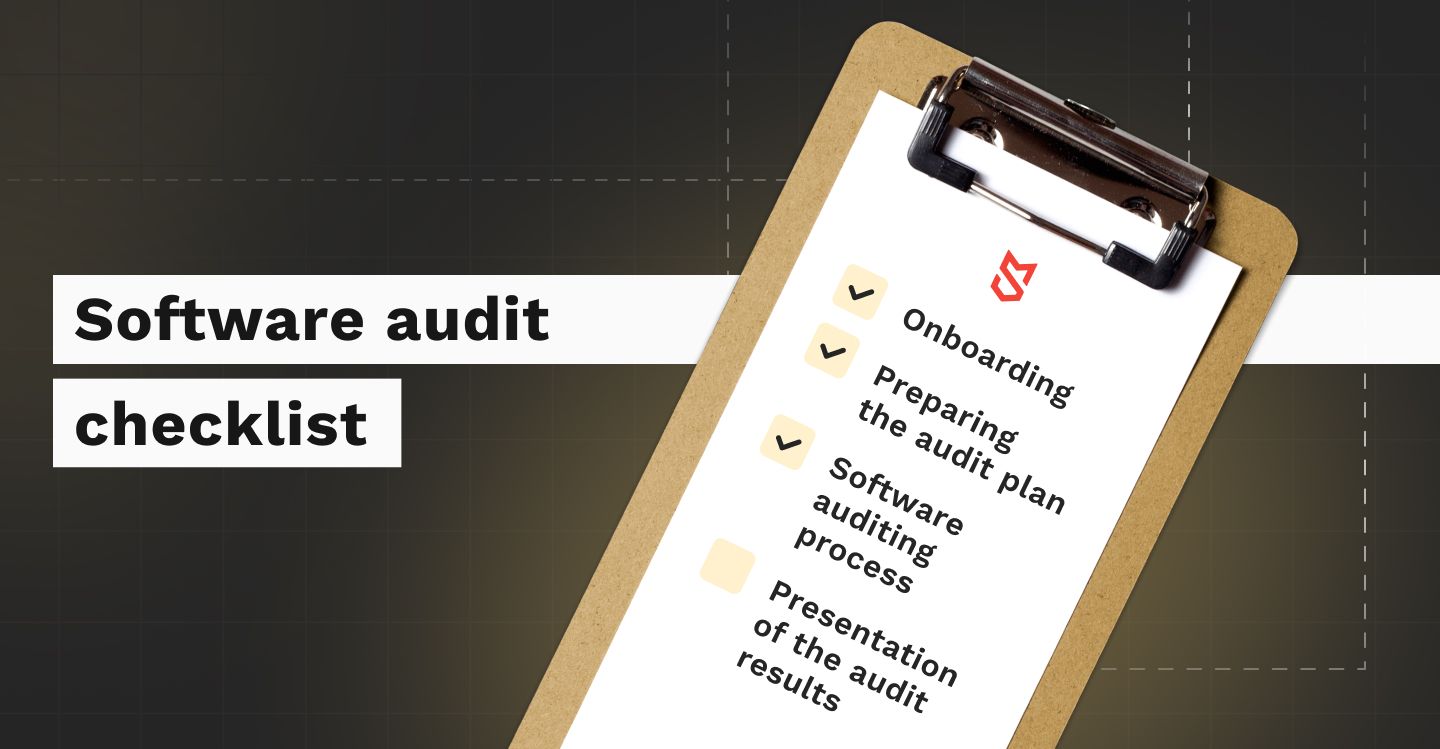
Even if your in-house team is not the one performing the software audit, you need to have at least a basic understanding of what this process involves. That is why we drew up a software audit checklist that will help you make sure the inspection is done as efficiently as possible.
1. Onboarding
In case of an external software audit, the first thing you will need to do is provide the company conducting it with all the necessary documentation and access to the components of the software that need to be analyzed. The onboarding process usually involves meetings with the party conducting an audit to specify all the necessary details.
2. Preparing the audit plan
Once both parties sort out all the details, they can create a software audit plan with a list of steps to take. This includes the objectives and KPIs of the audit, the deadlines, the budget for changes that the software owner can allocate, and so on.
3. Software auditing process
The components of this stage depend on the goals of the audit. However, as a rule, they include the software architecture and functionality analysis, initial QA testing and code analysis followed by refactoring or rework recommendations and work scope estimation.
The process also includes documentation work, where developers and QA engineers keep a record of the results they receive during the auditing process. Later on, those will be presented during the software audit report.
4. Presentation of the audit results
After conducting the audit, the team prepares a comprehensive report that includes the analysis of software and the suggestions for improvement. During the presentation, the parties can discuss the details of the report and work out further strategy. You can find out more about what this document consists of in the next section of the article.
The software development audit checklist can slightly differ depending on the type of inspection and your specific needs, but this list covers all the basics.
What should be included in the results of the software audit?
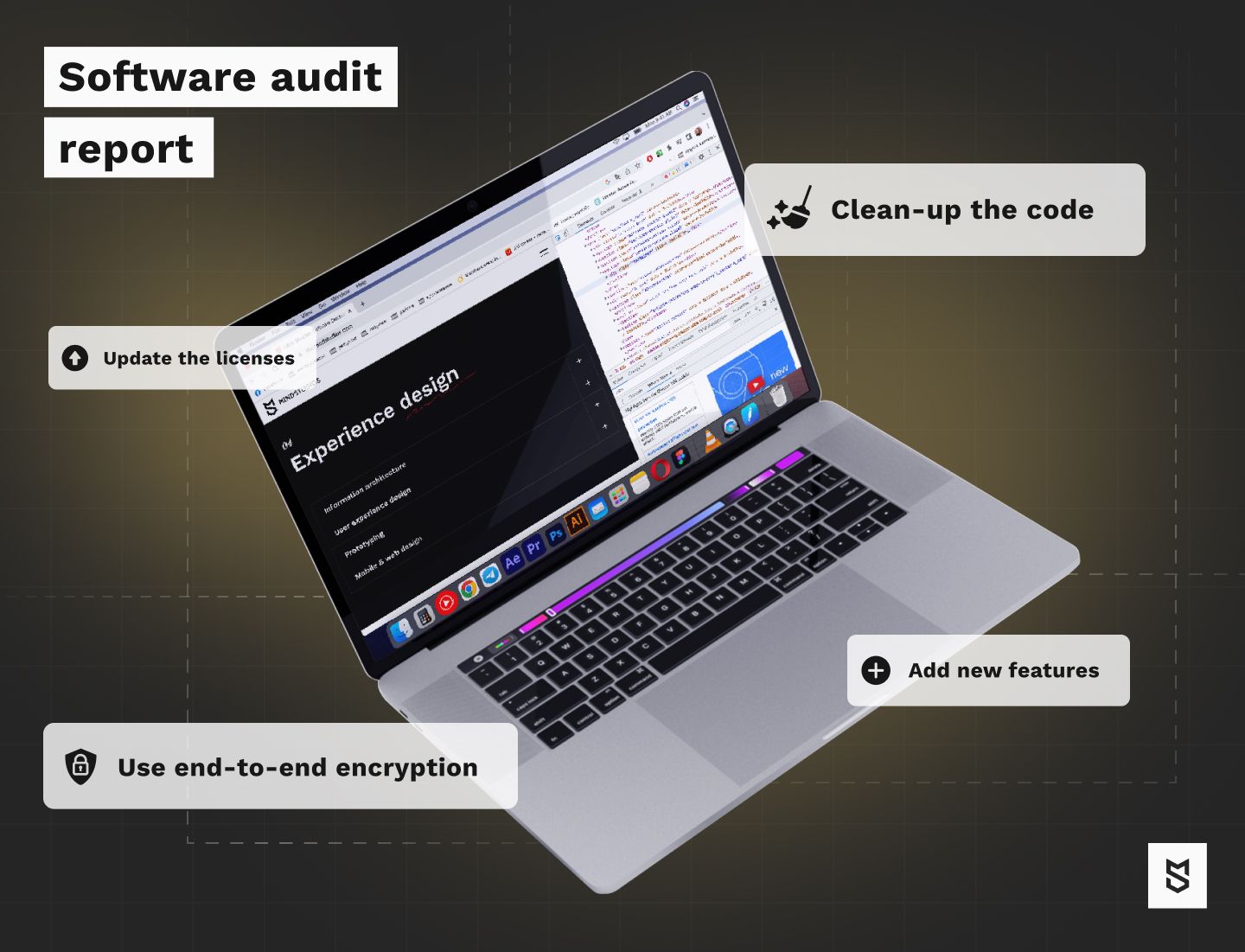
Once the software audit is complete, the team performing it presents the main result of the procedure — an audit report. Basically, it’s a summary of the issues that have been detected, suggestions on how they can be resolved, and milestones that need to be reached before the next audit.
The suggestions vary depending on the type of report, but the most common ones include:
- Recommendations for code improvement, including code clean-up and changes to code structure and style
- Suggestions for solutions to existing bugs, unused modules, conflicting logic in the modules, and so on
- Proposals regarding software logic improvements, performance enhancement, adding new efficient technical features, improving software security, and getting rid of redundant software tools
The suggestions in the report need to be categorized by the urgency of the tasks. For instance, a data breach risk will be more critical than making changes to the user interface. Mind Studios’ team also takes into account the budget our clients have for the nearest changes, and adjusts the suggestions accordingly.
Another important part of a software audit report is estimations for code refactoring and rework scope. Often, the party conducting a software audit and preparing the report can even include suggestions for software development vendors who can implement the proposed improvements.
However, when requesting an audit by Mind Studios, you can turn directly to us to carry out those suggestions. Our company has an established in-house team of business analysts, UI/UX designers, and software engineers who have the experience and expertise to help you upgrade your product.
Why choose Mind Studios as your software audit partner
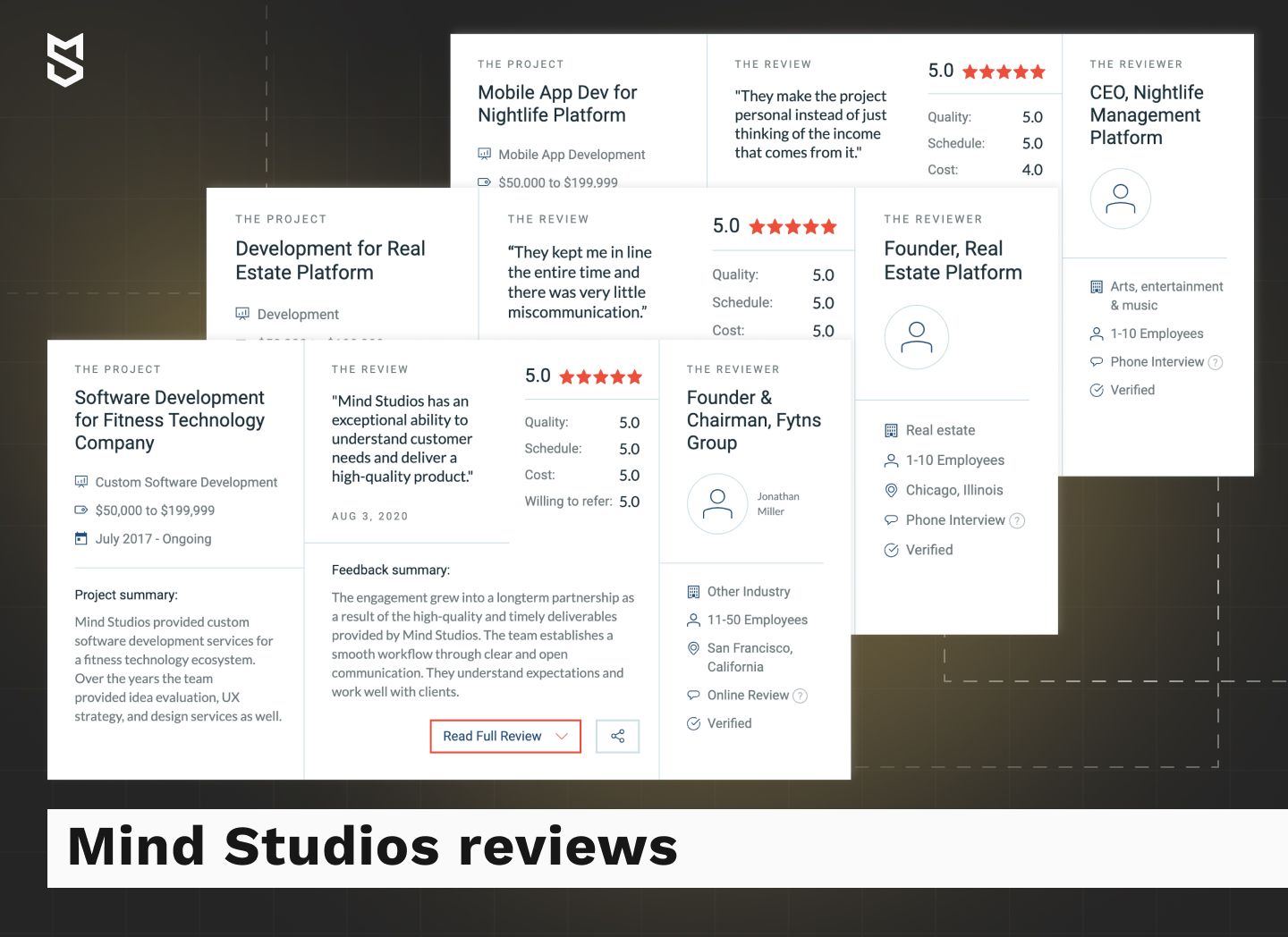
Regular internal software auditing makes the process of external examinations less stressful — and even less frequently needed. However, sometimes you just can’t do without the expertise of a third-party organization, and here is where cooperation with Mind Studios can be useful.
To help you better understand what software audits conducted by Mind Studios look like and how they can benefit your business, we talked to Mind Studios’ CEO Dmytro Dobrytskyi about our company’s approach to the process:
“The first thing you need to do when requesting an external audit is define its main objectives. For instance, a software owner can say “I want to understand whether my system is ready for scaling or not, see if it’s well-documented, or check how stable the infrastructure is” — and that’s a good start.”
Dmytro says that the most common case of requesting an external audit is when software owners have a software contractor instead of an in-house team and want to make sure that the hired specialists are doing a good job.
Another sensible and quite popular reason to request an external audit of software is to check if it is worth investing in. Just like financial due diligence, a software audit is an essential part of buying and investing in software products. This helps investors and buyers make sure their money is not going to waste and check whether the product they are interested in can help them meet their business goals.
For instance, if you’re buying a system that currently has 5 thousand users, and you are planning to increase this number to 100 thousand — you need to make sure that the system will endure such user growth.
When asked why Mind Studios is worth choosing as a software audit partner, Dmytro explains:
“Conducting a software audit involves a wide range of aspects, but the most significant ones are connected to the product architecture, infrastructure, and code quality. However, though the recommendations by external auditors are usually justified, not all of them are adjusted to the business resources.
Over the years, Mind Studios has developed projects for both small startups and large, well-established companies. This experience taught us to understand the projects’ needs at every stage of their life cycle.”
The solutions suitable for successful and profitable software projects can obviously be unaffordable for a small business starting off with an MVP. Therefore, our rule of thumb is to always work out a smart balance between the budget, the recommendations, and the tech instruments needed to fulfill them.
“Having in-depth knowledge of various industries and experience working with multiple technologies means that Mind Studios’ team knows what can be sacrificed for the time being and what needs to be done right away. Such an approach allows us to always be mindful of our clients' criteria and resources, and help them improve their products while sticking to the budget.”
The concrete proof of the benefits of such an approach is multiple projects that started off with a software audit — and ended up with our clients trusting us to implement the suggestions we made.
For instance, our biggest projects Fitr, a remote coaching platform, and Envol, a wellness application, both started with a software audit because the clients weren’t satisfied with their existing solutions. As a result, we became their outsourced software development partners and helped build products that corresponded with their business strategies.
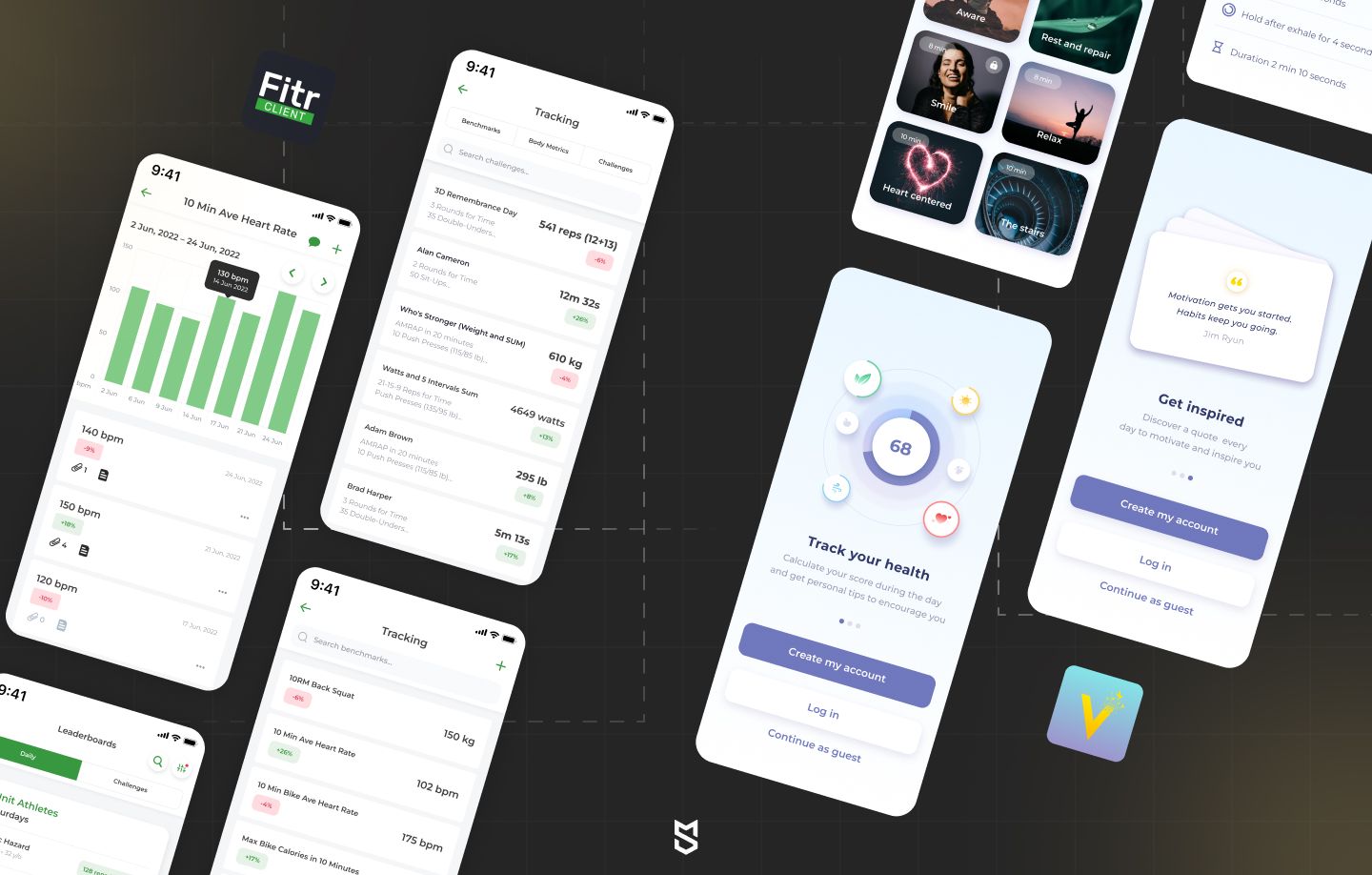
Summary
Software auditing doesn’t have to be a stressful process for your business. In fact, it can save you money in the long run if you make a habit of conducting regular internal evaluations and don’t let critical issues pile up. And even if the results of the audit show multiple issues that need to be addressed — you can still deal with them one step at a time, on your own terms.
We at Mind Studios always do our best to work out a strategy for improving our clients’ products while being mindful of the companies’ resources and current priorities. So, whether you feel there is a problem with your software that’s hard to detect or just want to double-check if everything works properly — don’t hesitate to contact Mind Studios and request a free consultation.


